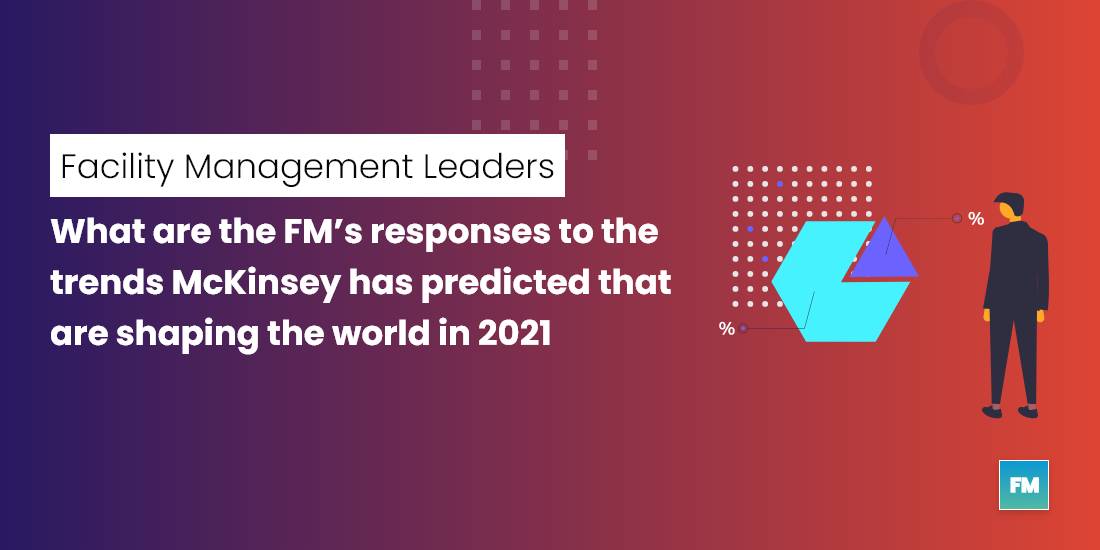Last week, Umesh Bhutoria (Founder, CEO Xempla) shared an insightful podcast from McKinsey’s Inside the strategy room podcast series. Kevin Sneader, partner at Mckinsey shared his predictions on the top 8 trends that will shape the world in 2021. If we can call ‘binge listening’ an actual phenomenon, then this series has to be there on the playlist of an innovator, lateral thinker, and truth seeker.
We all have been coming across various discussions on how the post covid world will look like, how businesses will function and interact with different stakeholders, how psychological and behavioral changes of the consumers will shape the demand and supply landscape, Inter-dependencies of the businesses and their impact on the end consumers, etc.
But when it comes to managing the implications on facility management or the commercial real estate industry I often ponder upon the fact that, are we paying due attention? Both for the short and long-term goal setting, are we considering the changing consumer behavior? Importantly does it reflect in our strategic sourcing, contract management, or service delivery mechanisms?
Responding to the situation created by the pandemic was a primary aspect of change management. Hopefully, businesses are coming up with new strategic initiatives, rethinking their business innovations, and discovering new revenue opportunities as the post covid trends seem to be far more vivid and disruptive in nature.
In this article let’s examine some of the trends Kevin Sneader has discussed in the podcast and try to find out ways FM can respond or perhaps build upon them.
Fostering innovation:
Fun fact, Did you know that sir Issac Newton discovered gravity while working from home (in his backyard) during the great plague? He used his time wisely and went on discovering many more theories.
Let it be work from home policies, remote operations, health and safety measures, or even climate-related consensus. Many things used to define the conventional facility management operations have changed in the last 12 – 16 months. The COVID-19 crisis has created an imperative for companies to reconfigure their operations by transforming themselves.
It’s important that the innovation should not be limited to consumer-facing aspects but also focusing on:
- Hardcore O&M practices,
- Collaborative tech partnerships
- Contract structures.

Hybrid work environment:
According to McKinsey Global Institute’s report, more than 20 percent of the global workforce in sectors such as finance, insurance, and IT could work the majority of their time away from the office without affecting their work.
Although offices are reopening, It shouldn’t be a matter of simply opening the door. Instead, it needs to be part of a systematic reconsideration of what exactly the office brings to the organization. The fundamental need of coming to the office for the work is getting inspected
Even after we are witnessing the back-to-office movement in some parts of the world, we can not deny that the work from home is here to stay for a long time and the facility leaders need to
- Prepare their facilities to operate optimally in the particle occupancy levels.
- Respond to shared workspaces as it has seen marginal growth
- Workplace design retrofits to maintain air quality and hygiene.
- Plan to manage assets and teams remotely.
Sustainability is the focus:
In one of our earlier posts, we discussed the recent sustainable activities global organizations and cities are taking part in. From Europe’s ambitious net-zero target to US President Biden’s recent announcement on planning to modernize sustainable building infrastructure, every major government across the world is accelerating its efforts to bring down carbon emissions throughout the value chain.
It is not just a policy structure that’s making businesses think about their carbon footprints, but the investors are also increasingly trying to greenify their portfolios. They are investing in assets that are carbon-friendly and resilient in nature. This is probably the first time that your building’s energy consumption (resource intensity) may decide whether your next tenant would like to invest in your property or not.
For facility management firms, sustainability could be a USP to attract new opportunities, but before that, we need to introspect and check whether our teams are prepared for
- Strengthening data and application maturity for asset maintenance and energy efficiency initiatives
- Strategic involvement in performance-based contracts
- Change management for better transparency and resiliency
- Upskilling its workforce to get the best of human-machine collaboration
With proactive leadership from the facility management firms, we can turn this crisis into an opportunity. We sincerely hope that we learn from our understanding of microscopic and telescopic trends and their impacts on the work environment, technology adoption, and consumer behavior.

Leave a Reply